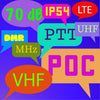
Common Two-Way Radio Acronyms and Lingo Explained
, by Joseph Gabriel, 1 min reading time

, by Joseph Gabriel, 1 min reading time
Two-way radios can boost your team’s communications. However, new lingo and unknown acronyms can stand in the way of clear, efficient communication. Therefore, mastering common two-way radio acronyms and lingo is not just a matter of protocol—it’s essential for clear, concise, and effective communication. Keep reading to have the most common two-way radio acronyms and lingo explained.
Two-way radios facilitate communication in a range of industries, all using the same acronyms. Here’s a breakdown of the essential acronyms and lingo you need to know:
CTCSS, or continuous tone-coded squelch system, filters unwanted transmissions by adding a low-frequency tone to the transmission. Only radios set to the same tone can hear each other, minimizing interference. Asking a coworker to use CTCSS can help you ensure clear communication.
DCS stands for digital coded squelch. It is like CTCSS but uses digital codes. DCS is more selective, offering clearer communication by blocking more unwanted transmissions.
Your coworker is referring to the push-to-talk button that activates the transmitter if they mention PTT. It’s a fundamental feature of two-way radios, allowing for quick and easy communication.
Voice-operated exchange, or VOX, enables hands-free operation. It activates the microphone when you speak and turns it off when you stop, making it perfect for multitasking.
Understanding these acronyms and employing them correctly can revolutionize communication within your team. For instance, using CTCSS can prevent crosstalk in crowded environments, while VOX functionality allows for seamless, hands-free communication during critical tasks. Each industry uses specific lingo that helps them communicate effectively in addition to these basic acronyms.
Two-way radios are indispensable tools across various industries, but leveraging their full potential requires understanding the above acronyms and lingo. With these common two-way radio acronyms and lingo explained you can ensure your team communicates effectively, enhancing safety, efficiency, and productivity.
Check out Atlantic Radio Communications Corp’s selection of two-way radios if you’re ready to put these acronyms to use. Check out our collection of Icom VHF radios to help your team communicate on the job.